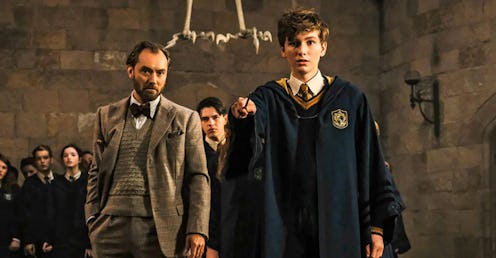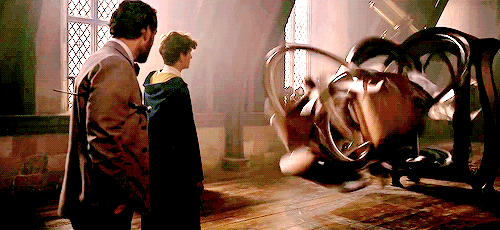Entertainment
The Harry Potter Easter Eggs In ‘Grindelwald’ Have A Deeper Meaning Than You Realized

The Harry Potter universe is a lot like the Star Wars universe in that the story uses family connections, destiny, and symbolic objects to connect generations of people to one another. In The Crimes of Grindelwald, the second film in the Fantastic Beasts saga, which opens this weekend, Eddie Redmayne returns as Newt Scamander in a darker adventure that lays more ground for Harry's history. While the first movie certainly featured some callbacks to the original Harry Potter films, in an effort to connect this world of 1927 with that of Harry, Ron, and Hermione, Crimes of Grindelwald includes tons of Harry Potter Easter eggs.
Which totally makes sense, considering we have to get from the roaring '20s to the movies and characters we know and love. These prequels definitely seek to expand the universe and to do so they have to include recognizable things, characters, names, and places. Crimes features a lot of Harry Potter callbacks to ground us back into a familiar world, even though it takes place decades before the main action that we know best.
Here are all of the Easter eggs we managed to catch while watching the latest movie. Warning, spoilers ahead for Fantastic Beasts: The Crimes of Grindelwald!
A Phoenix
Dumbledore's pet phoenix, Fawkes, was apparently a part of his destiny all along. As Dumbledore (Jude Law) explains to Newt (Eddie Redmayne) in The Crimes of Grindelwald, a phoenix will come to any Dumbledore in need. Fawkes hasn't appeared to Dumbledore just yet in this movie, implying his need will come some time in the future. But at the end of the film, a phoenix does come to Credence, AKA Aurelius Dumbledore, Albus' possible brother.
Hogwarts
One thing what audiences are going to love about The Crimes of Grindelwald is that the movie briefly takes us back to our favorite place: Hogwarts School of Witchcraft and Wizardry.
Dumbledore Teaching Defense Against the Dark Arts
Defense Against the Dark Arts is one of those notorious courses at Hogwarts that just cannot keep a steady teacher. Dumbledore always said he had been a Transfiguration teacher, but in Crimes, Dumbeldore is teaching the DADA class featuring a young Newt and young Leta LeStrange (Zoë Kravitz). And he's using...
A Boggart

When Newt faces the boggart in DADA, his worst fear is having a job that would require him to work at a desk. When Leta goes up against the boggart, however, the creature transforms into something much more mysterious.
The Dueling Club
When some Aurors come to Hogwarts to keep tabs on Dumbledore, he's overseeing another dueling club, similar to the kind that Gilderoy Lockhart is "teaching" in The Chamber of Secrets. There's even a young relative of Cormac McClaggen playing along!
The Whomping Willow
Also on hand at Hogwarts is the famous Whomping Willow tree that features in so many of the original Harry Potter movies. In Crimes, it's where Newt first shows Leta his pet bowtruckle.
McGonagall
Dumbledore does address a youngish, female professor as McGonagall in the film, but fans online were quick to point out that beloved professor Minerva McGonagall wasn't born until 1935, making her appearance in Crimes a little weird, considering the scene takes place about 15-20 years before that when Newt was still in school. Even the suggestion that the McGonagall in the movie could be her mother, Isobel, doesn't really work out, as Isobel was born in 1917, which is pretty close to the time when the scene takes place. Who is this mysterious McGonagall??
Nicholas Flamel & The Sorcerer’s Stone
One person whose age we don't have to question is that of immortal alchemist Nicholas Flamel, who makes an appearance in a big way in The Crimes of Grindelwald. Even more fun is seeing what's inside his safe when he opens it up: The Sorcerer's Stone.
Mirror Of Erised
In Crimes, Dumbledore uses the Mirror of Erised to look back on his blood pact with Grindelwald. So it seems like, while the mirror is used to give the audience a bit of backstory into their lives, the thing that Dumbledore still desires most is indeed Grindelwald.
“For The Greater Good”
The term "For the Greater Good" was first heard in Harry Potter and the Deathly Hallows, when Aberforth Dumbledore is retelling the story of his brother Albus, their sister Ariana, and what Grindelwald has to do with her death. In Crimes, Grindelwald uses the phrase as sort of a calling card when luring in his followers.
Portkeys
When Newt is banned from international travel, he and Jacob use a portkey to leave the country and land in France. Much like in the earlier Harry Potter movies, portkey travel can be a bit stomach churning.
Polyjuice Potion
To get inside the French Ministry of Magic when he's not supposed to be traveling outside of England, Newt uses some Polyjuice to take the form of his brother, Theseus. Much like in basically every other Harry Potter film, the method is risky, and doesn't last for long.
Parseltongue
When Grindelwald is in prison at the beginning of the film, it's said that he was very manipulative and he therefore had to have his tongue cut out. When one of his minions helps him escape, he recreates both of their tongues with magic and gives them pointed ends just like a snake. Perhaps Grindelwald can speak Parseltongue and was using his abilities to manipulate his captors
Thestrals
The fastest way to fly in the Harry Potter universe is to use these invisible, skeleton-like horses that can only be seen by people who have seen death. And it seems like everyone in The Crimes of Grindelwald can see them, which is pretty dark.
"The Boy Who Lived"
The Crimes of Grindelwald has a sub-plot involving Leta Lestrange's family, her lost brothers, and a prophesy. As Leta tells the story about her younger brother Corvus, and how Credence is connected, the whole thing has an air of the "boy who lived" prophecy that connected Harry Potter to Neville Longbottom and Voldemort.
An Unbreakable Vow
Leta Lestrange's other half brother, Yusef Kama, has scars on his hands that, as Tina notes suggest that he's made an Unbreakable Vow. Fans will recall that Snape made an unbreakable vow with Draco Malfoy's mother, and like that vow, it becomes a big part of the story.
There of course might be more Harry Potter Easter eggs to catch on future viewings, but looking out for them is part of the fun!